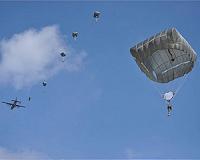| . |  |
. |
Patuxent River MD (SPX) Mar 04, 2011 Boeing and Bell Helicopter have applauded the Naval Air Systems Command (NAVAIR) V-22 Joint Program Office (PMA-275) announcement that the Bell Boeing-built V-22 Osprey fleet has surpassed 100,000 flight hours. The milestone arrived on Feb. 10 during a U.S. Marine Corps MV-22 Osprey combat mission in Afghanistan. Marine Medium Tiltrotor Squadron 264, currently operating out of Camp Bastion in Helmand Province, was identified as the squadron that eclipsed the 100,000-hour mark. "The entire Bell Boeing tiltrotor team congratulates our Marine Corps and Air Force Special Operations Command (AFSOC) customers on achieving 100,000 flight hours, and counting," said John Rader, executive director of the Bell Boeing V-22 Program. "The performance of the aircraft in combat and humanitarian missions has been truly remarkable. We continue to take great pride in providing our customers with this revolutionary capability." Marine Corps MV-22 and AFSOC CV-22 Ospreys amassed the flight hours while performing combat, humanitarian, training, and test and evaluation missions on land and at sea. Almost half of the total hours were flown during the past two years. This milestone marks the latest major achievement for a program that has seen 14 successful combat and humanitarian deployments since the Osprey was first declared operational in 2007. "The V-22 is proven and forward-deployed, supporting combat operations and responding to contingency operations around the world," said Marine Corps Col. Greg Masiello, head of the V-22 Joint Program Office (PMA-275) at NAVAIR. "The Osprey brings unprecedented range, speed and survivability to the warfighter and will continue to excel in combat and remain ready, effective and survivable." According to Naval Safety Center records, the MV-22 has had the lowest Class A mishap rate of any rotorcraft in the Marine Corps during the past decade. The aircraft's reduced susceptibility, lower vulnerability and advanced crashworthiness have made it the most survivable military rotorcraft ever introduced. Fiscal Year 2010 Navy flight-hour cost data also show that the Osprey has the lowest cost per seat-mile (cost to transport one person over a distance of one mile) of any U.S. Navy transport rotorcraft. "At 100,000 flight hours, safety, survivability and mission efficiency have become hallmarks of the operational fleet," said Mitch Snyder, deputy program director for the Bell Boeing V-22 Program. The V-22 Osprey is a joint service, multirole combat aircraft using tiltrotor technology to combine the vertical performance of a helicopter with the speed and range of a fixed-wing aircraft. With its nacelles and rotors in vertical position, it can take off, land and hover like a helicopter. Once airborne, its nacelles can be rotated to transition the aircraft to a turboprop airplane capable of high-speed, high-altitude flight. The tiltrotor aircraft is manufactured under a 50-50 strategic alliance between Bell Helicopter, a Textron Inc. [NYSE: TXT] company, and Boeing. The current V-22 Osprey program of record calls for 360 aircraft for the Marine Corps, 50 for AFSOC, and 48 for the Navy. More than 130 Osprey tiltrotors are currently in operation. Marine Corps MV-22s are currently deployed in Afghanistan supporting Operation Enduring Freedom and with the 26th Marine Expeditionary Unit supporting contingency operations, while AFSOC CV-22s are preparing to deploy once again in support of ongoing Special Operations missions.
Share This Article With Planet Earth
Related Links - The latest in Military Technology for the 21st century at SpaceWar.com
 BAE Receives Contract For T-11 Parachutes
BAE Receives Contract For T-11 ParachutesPhoenix AZ (SPX) Mar 04, 2011 BAE Systems has been awarded a $5 million order to produce T-11 Personnel Parachute Systems for the U.S. Army. BAE Systems' T-11 Personnel Parachute System provides optimal safety for paratroopers through an improved harness system and large canopy. Replacing the predecessor U.S. Army T-10 parachute, the T-11 Parachute allows jumpers to carry heavier payloads critical to their mission whil ... read more |
|
| The content herein, unless otherwise known to be public domain, are Copyright 1995-2010 - SpaceDaily. AFP and UPI Wire Stories are copyright Agence France-Presse and United Press International. ESA Portal Reports are copyright European Space Agency. All NASA sourced material is public domain. Additional copyrights may apply in whole or part to other bona fide parties. Advertising does not imply endorsement,agreement or approval of any opinions, statements or information provided by SpaceDaily on any Web page published or hosted by SpaceDaily. Privacy Statement |